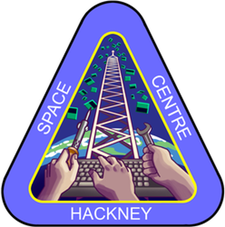Difference between revisions of "Hackney Space Centre Plan"
m |
|||
| Line 63: | Line 63: | ||
== Miscellaneous Ideas == | == Miscellaneous Ideas == | ||
| − | * Brew a commemorative HackSat beer | + | * [[Brewing|Brew a commemorative HackSat beer]] |
* Fabric mission decals | * Fabric mission decals | ||
* Hackney Space Centre sign based on decal | * Hackney Space Centre sign based on decal | ||
Revision as of 15:45, 9 August 2013
HackSat One is due to launch on 9th December 2013. This page summarises ideas for areas to work on for Hackney Space Centre prior to launch.
For an introduction to the project check out https://flux.org.uk/projects/hacksat/. There is also a Satellite FAQ.
NB. This page is very much a work in progress, feel free to add your own ideas and plans.
Mast & Antenna
In order to be able to receive signals from HackSat at the Hackspace we need an antenna that can see south and isn't obstructed by buildings. This is the initial priority as it's a big job and critical to the project.
- Making mast trailer operational (can extend to 30m, so easily tops local buildings)
- Remove paint/rust - in progress
- Painting with yellow Hammerite
- Get engine and compressor working
- Check pneumatic system for leaks
- Strip down mast, grease and reseal
- Steerable antenna
- Need 70cm antenna (we do have some handheld ones, but these may not be suitable for mounting without modification)
- Artag is loaning a rotator, will need something to raise antenna too
- Control software for steerable antenna
- Test with ISS and FUNcube prior to HackSat launch
- Antenna Feeder
- We have a some good quality coax. We're unsure if there is enough to reach the antenna with the mast raised.
- The received signal will be very weak. Losses in the feeder would probably render it unreadable by the time it reaches the receiver.
- One solution is to add a linear amplifier.
- Another option is to mount an rPi/funcube device to the mast and run Cat5 back to the space. This would be difficult to reach if it needed attention, however.
Signal Decoding
There are 128 sprites to decode. At present decoding in real time requires ~ 2 x 2.5GHz Core2 core. It needs length 640 complex FFT at every sample (64kHz) for each of the 128 sprites. Currently uses fftw.
- We will be using a FUNcube Dongle Pro+.
- GNU Radio programming/automation (we already have decoding working for a single sprite)
- Borg and sister servers have 64 cores (or perhaps even 256), estimate we'd need all four running for ~2 hours a day during mission. If we have 256 cores we should only need 30 minutes a day during the mission. Need to look into this idea in more detail.
- Is there any way to increasing speed of FFT (GPU? AVX? FPGAs?)
Mission Control
To see results, work with other ground stations and manage the mission.
- Tracking ISS and HackSat Orbit
- Communications with other ground stations and main KickSat mission control
- Visualising decoded data from our and other ground stations, e.g. spinning 3D model of sprite matching actual motion of HackSat
- Physically building out area in Hackspace with monitors, comms etc.
- Where does this go physically in the Space?
Science!
HackSat can only transmit a little basic data, but that doesn't mean we can't learn interesting things. The sensors can measure:
- temperature
- magnetic field
- spin rate
- time since exiting Earth's shadow
Publishing
- Make data from our ground station available online
- Twitter feed from HackSat One
Potential Workshops
- GNU Radio and cheap SDR
- Astronomy
Launch Party
- Video feed of Falcon 9 launch
- Video link to main mission control for KickSat
- LHS Bikeshed
- ...
Miscellaneous Ideas
- Brew a commemorative HackSat beer
- Fabric mission decals
- Hackney Space Centre sign based on decal
- ...
